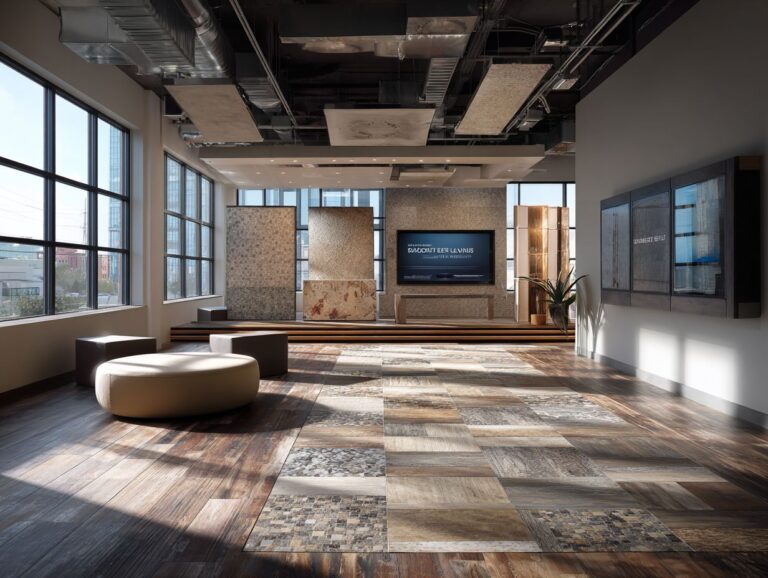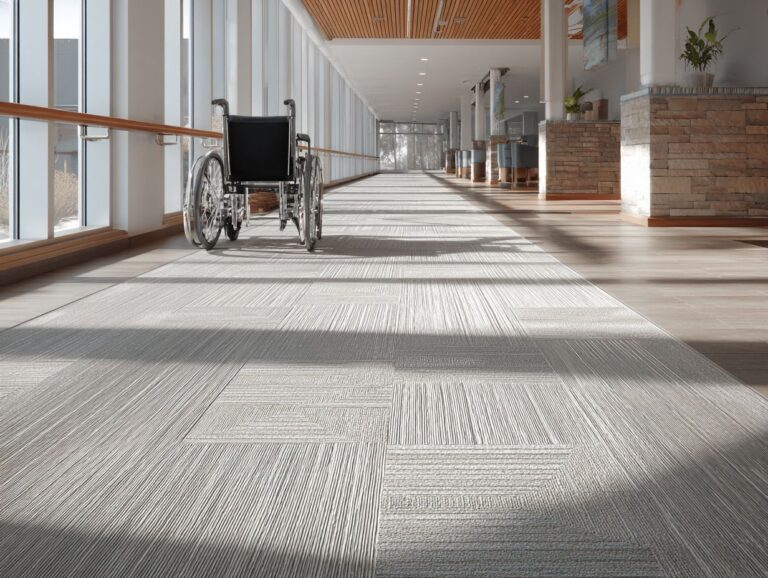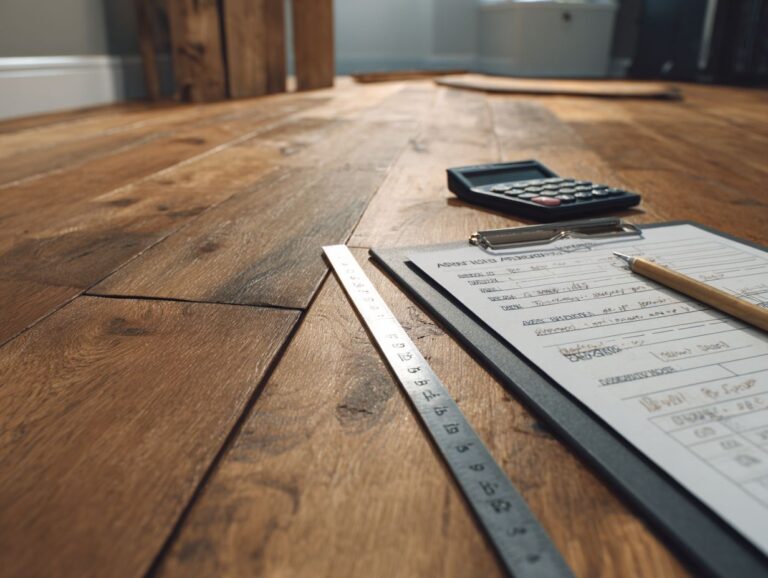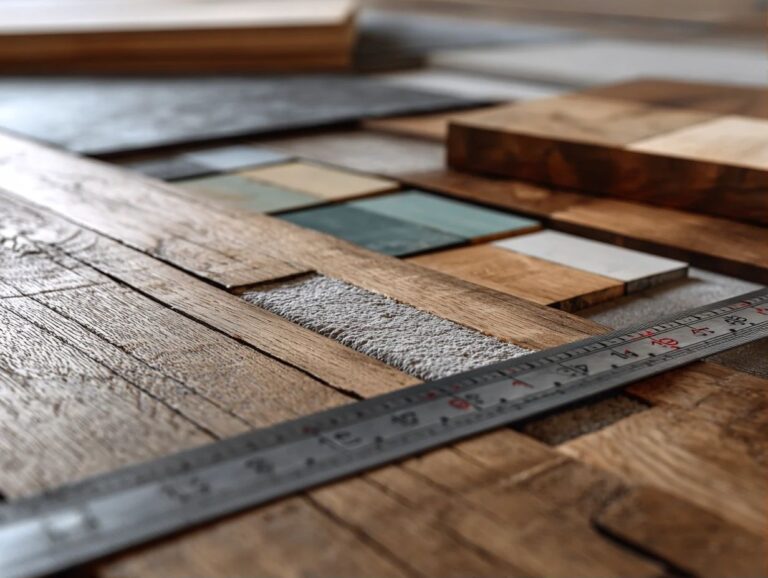Flooring Acclimation Process – Why Time Matters
When installing new flooring, it is important to know the acclimation process, especially for Luxury Vinyl Plank (LVP) and hardwood. In Springfield, IL, where the weather changes, it’s important to let your vinyl plank and hardwood floors adjust to the environment for them to work well. This article explains why spending time to get your flooring materials used to the environment is important. It outlines effective methods and errors to avoid for durable results. Get ready to safeguard your investment!
Key Takeaways:
Contents
- Getting to Know the Flooring Acclimation Process
- Flooring Acclimation Time Statistics
- Why Time Matters in Acclimation
- Types of Flooring Materials and Their Acclimation Needs
- Best Practices for Acclimating Flooring
- Common Mistakes in the Acclimation Process
- Monitoring Acclimation Progress
- Frequently Asked Questions
- What is the flooring acclimation process and why is time important?
- How long should you wait before installing new flooring?
- What factors can affect the flooring acclimation process?
- Can skipping the flooring acclimation process cause problems?
- What can you do to help the flooring acclimation process?
- Is there a way to speed up the flooring acclimation process?
Definition of Acclimation
Acclimation is the process where flooring materials get used to the temperature and humidity of the place before being installed.
This step is important for both hardwood and vinyl plank flooring to avoid problems like bending or lifting.
For hardwood, it’s recommended to allow planks to acclimate for 3-5 days, stored in the room where they’ll be installed, ideally at 60-80 degreesF with 30-50% humidity.
In contrast, vinyl plank flooring may require just 24-48 hours of acclimation, as it is less sensitive to changes in moisture.
Using a hygrometer can help monitor the conditions, ensuring optimal stability for your flooring long-term.
Importance of Acclimation
Getting used to the environment is important because it minimizes issues like gaps, bending, and bulging that can happen with flooring that hasn’t been correctly prepared.
Let your flooring materials sit in the room where they will be installed for at least 48 hours before starting. This lets them adjust to the room’s temperature and humidity.
For instance, hardwood flooring can absorb moisture from surrounding air, which may cause expansive warping if not addressed. Use a hygrometer to monitor humidity levels, aiming for a consistent range of 35-55%.
Place acclimating boards around the room to gauge reaction and verify that conditions are suitable before installation. This proactive approach can significantly minimize potential issues.
Getting to Know the Flooring Acclimation Process
Getting the flooring ready means knowing how it adjusts to the surroundings for the best installation.
What Happens During Acclimation?
During the adjustment period, flooring materials take in or let out moisture until they match the moisture level of the room. The length of this process can vary based on the material, ranging from a few days to a few weeks.
For example, solid hardwood typically requires 5 to 14 days to acclimate, while engineered wood may need just 48 hours. Vinyl flooring, on the other hand, can often be installed right away since it’s less sensitive to moisture changes.
To properly adjust, use a moisture meter before and during the process; wood moisture should be between 6-9%. Monitoring relative humidity in the room also helps maintain a stable environment, preventing warping and ensuring the longevity of your flooring.
Factors Affecting Acclimation Time
The time it takes to adjust depends on different things, such as the kind of flooring, the current amount of moisture, and conditions like temperature and humidity.
For instance, hardwoods like oak and maple typically require longer acclimation periods than softer woods, often needing 5-7 days. On the other hand, engineered wood may acclimate in 2-3 days.
To effectively monitor moisture, use a moisture meter; brands like Wagner and General Tools offer reliable options. Maintaining indoor humidity levels between 30-50% can expedite acclimation.
Reference guidelines from the National Wood Flooring Association to tailor your approach based on specific wood species and regional climate, ensuring optimal installation results.
Flooring Acclimation Time Statistics
Flooring Acclimation Time Statistics
Recommended Acclimation Times: Solid Hardwood Acclimation
Recommended Acclimation Times: Engineered Hardwood Acclimation
Environmental Conditions: Humidity Range for Acclimation
Environmental Conditions: Temperature Range for Acclimation
Moisture Content Guidelines: Solid Hardwood Moisture Difference
The Flooring Acclimation Time Statistics data provides essential guidelines for acclimating flooring materials, ensuring stability and performance in their final environment. Proper acclimation prevents issues like warping or gapping, which can occur when flooring materials adjust to new environmental conditions. This dataset provides detailed information about suggested times for adjusting, environmental factors, and moisture levels that are important for both solid and engineered hardwood floors.
Recommended Acclimation Times highlight the differences between solid and engineered hardwood flooring.
- For solid hardwood, the acclimation period ranges from a minimum of 5 days to a maximum of 7 days. This extended period is necessary due to solid hardwood’s sensitivity to environmental changes.
- In contrast, engineered hardwood requires a shorter acclimation period of 2 to 3 days, thanks to its manufactured layers that provide greater stability.
Environmental Conditions play a critical role during the acclimation period. The ideal humidity range is between 30% and 50%, ensuring that the wood does not absorb excess moisture or dry out too much. Similarly, the temperature range for optimal acclimation is set between 60 degreesF and 80 degreesF, mimicking typical interior conditions. Maintaining these conditions helps to minimize the risk of damage once the flooring is installed.
Moisture Content Guidelines are essential for installing solid hardwood, especially when looking at the width of the boards.
- For boards less than 76mm in width, the maximum allowable moisture content difference is 4%. This leniency accommodates slight variations while retaining structural integrity.
- For boards wider than 76mm, a tighter maximum difference of 2% is recommended to prevent excessive expansion or contraction that could lead to splitting or buckling.
The acclimation statistics offer a clear guide for getting hardwood flooring ready to be installed. By following these guidelines, installers can make sure that both solid and engineered hardwoods fit well in their new settings. This helps the flooring last longer and look better, while reducing possible issues from changes in the environment.
Why Time Matters in Acclimation
Time is important for adjusting, as not enough time for this can cause serious problems with how flooring works.
Impact on Flooring Performance
Adequate acclimation directly correlates to the longevity and stability of flooring materials, impacting their expansion and contraction behavior post-installation.
To get the best results, manufacturers suggest waiting at least 48-72 hours before installing, especially for hardwood and laminate floors.
For instance, if you’re working with solid hardwood, placing the planks in the room where they’ll be installed allows them to adjust to temperature and humidity levels.
Research shows that non-acclimated flooring can lead to gaps of up to 1/8 inch or buckling, resulting in costly repairs. A hygrometer can be used to check humidity levels, helping determine when acclimation is complete.
Consequences of Inadequate Acclimation
Failing to acclimate flooring can result in serious problems including warping, buckling, and gaps, which compromise both aesthetic and functional qualities.
One notable case involves a home renovation where hardwood flooring was installed without proper acclimation. Within weeks, the planks began to warp, leading to costly repairs.
To prevent this, always allow hardwood to sit in the installation area for at least 72 hours. Use a moisture meter to check moisture content before installation; a difference greater than 4% between the subfloor and planks indicates a potential issue.
Consider using a dehumidifier in humid environments to create a stable setting for your flooring.
Types of Flooring Materials and Their Acclimation Needs
Different types of flooring need to adjust to their environment in specific ways for the best installation results.
Hardwood Flooring
Hardwood flooring needs at least 72 hours to adjust, during which moisture levels should be checked with a moisture meter for stability.
To improve adjustment, think about the type of wood you are using. For example, oak typically requires lower humidity levels (30-50% relative humidity) compared to maple, which can tolerate slightly higher conditions.
Use a digital moisture meter to check both the flooring and the room environment, aiming for a wood moisture content between 6-9%. Keep the flooring in its installed environment during acclimation, avoiding direct sunlight and extreme temperatures to prevent warping or cupping once installed.
Laminates
Laminate flooring generally requires less acclimation time than hardwood, often just 24-48 hours, but still benefits from monitoring temperature and humidity levels.
For the best results after installation, keep room temperatures between 60 degreesF and 80 degreesF and humidity levels between 30% and 50%. This helps prevent expansion or contraction.
Manufacturer guidelines may specify placing unopened laminate boxes in the installation area during acclimation to equalize moisture content. Always refer to specific product recommendations for best results, as some brands may require longer acclimation times depending on their materials and finishes.
Vinyl and Linoleum
Vinyl and linoleum flooring usually need just a short waiting time, often only a few hours, which makes them a practical option for fast installations.
Unlike hardwood, which can take days to acclimate, vinyl and linoleum products are ready for use almost immediately after installation. Make sure the subfloor is clean, dry, and even to avoid problems like bubbling.
When installing, use a ruler and a utility knife to make exact cuts, and a rubber mallet to join seams tightly. Always allow the flooring to relax in the room it will be installed in for a couple of hours before beginning, which helps to eliminate curling edges and facilitates smoother application.
Tile and Stone
Tile and stone flooring do not require traditional acclimation, but proper handling and moisture control are essential to prevent damage during installation.
For the best results, keep tiles and stones in a room with a steady temperature before you install them. This minimizes moisture absorption and warping.
Before laying the flooring, check the moisture levels of the substrate using a moisture meter, aiming for readings below 4% for concrete and under 10% for wooden substrates.
Consider using a dehumidifier in humid conditions and allow materials to adjust to room temperatures for 24-48 hours. These steps will help create a stable and durable flooring foundation.
Best Practices for Acclimating Flooring
Following the recommended steps during the adjustment period helps flooring materials settle properly, resulting in effective installations. For an extensive analysis, our comprehensive guide on reclaimed wood flooring covers sourcing, costs, and installation, which can further enhance your understanding.
Optimal Conditions for Acclimation
The optimal conditions for acclimating flooring materials typically include a humidity level between 30-50% and a temperature range of 60-80 degreesF.
To maintain these conditions effectively, use tools like the Bessemeter DS500, which measures both temperature and humidity levels in real-time.
Set up the device in the acclimation area, ensuring it remains undisturbed. Adjust heating and cooling systems as necessary to stay within the ideal temperature range. Employ a humidifier or dehumidifier to regulate humidity.
Check readings every few hours to quickly address any changes, ensuring your flooring materials settle properly and reduce the risk of warping or cracking after installation.
Duration Recommendations for Different Materials
Duration recommendations for acclimation vary significantly across materials, with hardwood requiring 72 hours, while laminates may need just 24-48 hours.
For engineered wood, an acclimation period of 48 hours is ideal, allowing the material to adjust to the environment while minimizing expansion or contraction.
Meanwhile, vinyl flooring can often be installed immediately, as it does not typically require acclimation.
For the best outcome, check the room’s humidity and temperature before starting. Keep the flooring in that room while it adjusts.
This attention to detail can help avert issues like warping or buckling down the line.
Common Mistakes in the Acclimation Process
Recognizing frequent mistakes during the adjustment period can help avoid expensive errors in flooring installations.
Rushing the Acclimation Period
One of the most frequent mistakes is rushing the acclimation period, leading to significant issues like gaps and buckling in the flooring post-installation.
Studies show that improperly acclimated hardwood can shrink or expand as much as 1-2% due to environmental changes. A project in Texas had significant flooring issues because they didn’t wait the suggested 72 hours for acclimation, leading to repair costs of over $3,000.
To avoid these problems, store flooring materials in the room where they will be used for at least three days and check the humidity levels in the room.
Using a hygrometer can help monitor moisture levels, ensuring that they remain within the recommended range.
Ignoring Environmental Factors
Ignoring environmental conditions such as temperature and humidity can lead to issues with flooring over time.
To maintain optimal conditions, start by using a hygrometer to monitor humidity levels, aiming for 30-50%. Invest in a digital thermometer for consistent temperature checks, ideally between 60-80 degreesF.
Before installation, acclimate your flooring materials in the intended space for at least 48 hours. Avoid common pitfalls like placing flooring directly in front of heating vents or windows, as this can lead to uneven acclimation.
Keep checking the environment after installation to maintain performance.
Monitoring Acclimation Progress
Frequently check how well the flooring materials have adjusted to the environment to make sure they are ready for installation.
Tools for Measuring Humidity and Temperature
Effective tools for measuring humidity and temperature include digital hygrometers and moisture meters like the Bessemeter DS500, ensuring optimal acclimation.
The Bessemeter DS500 gives accurate measurements and costs between $40 and $70, making it a good option for dedicated fans.
For more budget-friendly options, consider the AcuRite 00524, which retails around $30 and provides essential humidity and temperature readings.
The Govee Thermo-Hygrometer offers extra functions by showing current information on your phone via Bluetooth, costing about $25.
Each of these tools helps maintain the ideal conditions for your plants and materials, ensuring effective acclimation.
Signs of Proper Acclimation
Key signs of proper acclimation include stable moisture content readings and the absence of physical changes in the flooring materials.
Monitor the temperature of the environment, ensuring it stays within the manufacturer’s recommended range.
Check the floors regularly and note any changes like bending or curving.
Use a moisture meter to check readings at various points, aiming for consistency within 2-4% of the target levels.
Experts also suggest establishing a timeframe for acclimation, typically one to two weeks, allowing materials to adjust fully before installation starts.
Implementing these methods guarantees a successful acclimation process.
Recap of Importance of Time in Acclimation
To conclude, investing time in the acclimation process is essential for ensuring the durability and performance of your flooring materials.
This involves letting the flooring materials sit in the installation environment for a minimum of 48 hours. For example, if you’re using hardwood, place the planks in the room where they will be installed so they can adjust to the temperature and humidity levels.
Using a hygrometer to monitor moisture levels can help you determine the ideal conditions. Make sure to check manufacturer recommendations regarding acclimation times, as some materials may require longer.
Thorough preparation results in easier installation and a floor that lasts longer.
Frequently Asked Questions
What is the flooring acclimation process and why is time important?
The process of getting new flooring ready involves giving it time to get used to the room’s temperature and humidity. This is important because it allows the flooring to expand or contract before installation, preventing potential issues and ensuring a longer lifespan for the flooring.
How long should you wait before installing new flooring?
The recommended time for flooring acclimation varies depending on the type of flooring and the installation environment. In general, it is recommended to wait at least 24-48 hours before installation, but some materials may require longer acclimation periods.
What factors can affect the flooring acclimation process?
The temperature and humidity of the installation environment are the main factors that can affect the flooring acclimation process. Any significant changes in these factors can impact the flooring’s stability and lead to issues such as warping, buckling, or gaps.
Can skipping the flooring acclimation process cause problems?
Yes, skipping or rushing the flooring acclimation process can lead to many problems with the flooring over time. It is important to follow the manufacturer’s recommendations and allow the proper amount of time for acclimation before installation.
What can you do to help the flooring acclimation process?
You can help the flooring acclimation process by ensuring that the installation environment is within the recommended temperature and humidity range. You can also open up the packaging of the flooring and spread them out in the installation area for better air circulation.
Is there a way to speed up the flooring acclimation process?
No, there is no way to speed up the flooring acclimation process without risking potential issues with the flooring. To get the best results from your new flooring, follow the suggested time frame.




